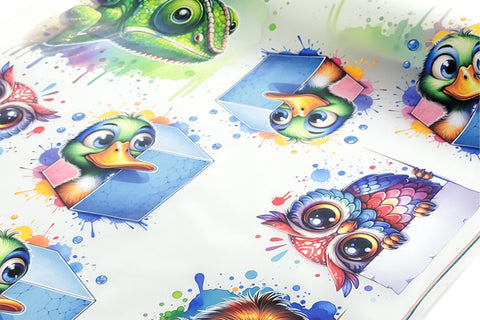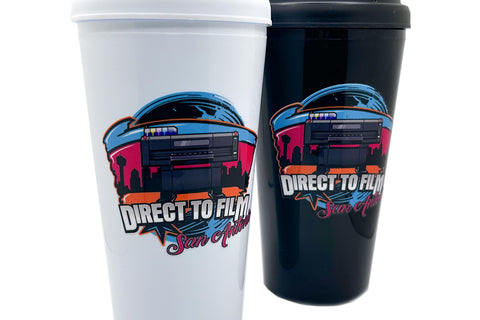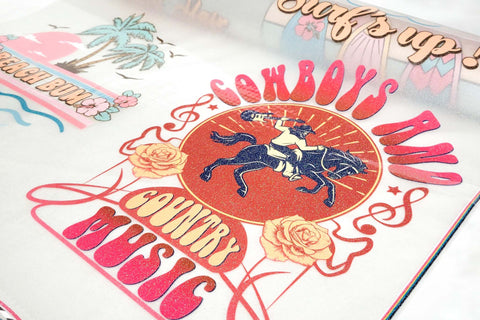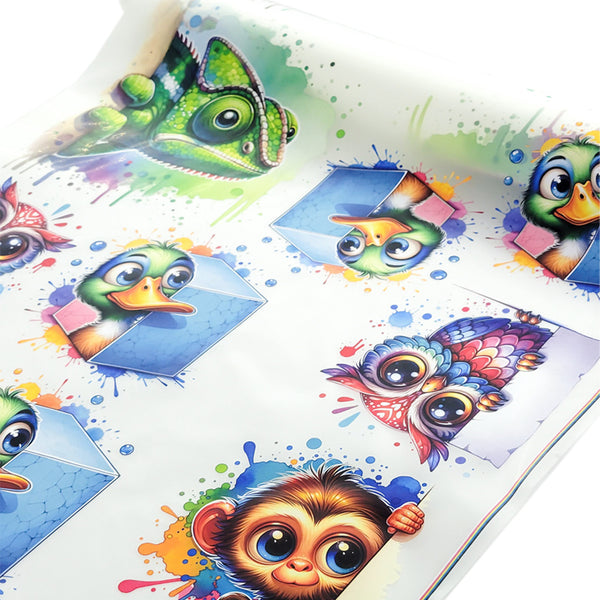DTF printing is a revolution in textile printing, and you can turn your favorite artwork in digital form into a physical print on your apparel. If you are a self-made designer or a small business owner, then you might be thinking, how does DTF work, or how to make DTF transfers. This guide solves all your queries!
What is DTF Printing?
DTF (Direct-to-Film) printing is a modern transfer method where you can create an artwork digitally and print the designs onto a specialized PET film and transfer it onto a fabric. It is not like DTG printing, which applies ink directly onto garments.
DTF involves an intermediate film layer that provides more durable, colorful, and vibrant prints on multiple fabric materials and even non-textile items like bags or hats. Like other printing methods, DTF has its own pros and cons but for most beginners and DIY enthusiasts, the benefits often outweigh the drawbacks.
How Does DTF Printing Work? - Process to Make DTF Transfers
Now you will have an idea about how direct-to-film printing works. Here is the step-by-step process for your assistance:
Step#1: Gather the Tools
Direct-to-Film needs special tools, and here are those:
-
Artwork software such as Adobe Illustrator or CorelDRAW for designing.
-
DTF Printer that prints at 1200+ dpi for sharp details. You can go for either Epson-based modified printers or industrial-grade options like ColDesi or DTF Superstar.
-
White ink and pigment-based CMYK inks. Make sure they are water-based and eco-friendly.
-
PET transfer film (polyester) as a transfer medium. They are available in rolls or sheets.
-
Thermoplastic adhesive powder that bonds the design to fabric.
-
Heat press machine.
-
A mesh shaker or automatic powder applicator.
If you want durable DTF gang sheets or stickers, you can visit DTF SAN Antonio.
Step#2: Prepare Your Design
On the software, create your favorite design, whether a logo, your favorite character, or anything you want. Keep in mind that DTF transfers demand a mirrored design, which means the right side of your design will be on the left side when you transfer it onto the material. Your design should be in appropriate size.
Step#3: Print the Film
Set your DTF printer settings and load the PET film into the printer, and ensure it is positioned correctly for accurate printing. After that, handle the film with care to prevent smudging or damage.
Step#4: Adhesive Powder Application
Lay the printed film flat and apply the adhesive powder with a mesh shaker. Then remove the excess powder and make sure it only remains on the inked area of the design.
Step#5: Transfer the Design
Now place the cured film on the fabric and set up your heat press machine (134-160°C for 10-15 seconds). Then, put the heat press on the fabric with proper alignment and pressure for a few seconds or a minute.
Step#6: Final Touch
In the end, let the fabric dry first and then peel off the film. Remove any residue from the printed fabric, and your final product is ready to wear.
Tips for Successful DTF Printing
Here are a few tips that can help you in creating successful DTF transfers:
-
Use high-quality films and eco-friendly inks for your DTF transfers for vibrancy and durability.
-
DTF printers are sensitive to dust and dried ink, so clean the printhead and nozzles frequently to avoid clogging and ensure good output. See the video.
-
Cure the DTF ink at the correct temperature and time. Improper curing can lead to cracks or peeling in the design after washing.
-
Most transfers require 280-320°F (140-160°C) for 15–20 seconds with medium pressure. Test before mass production.
-
Keep your DTF printed fabrics away from direct sunlight to avoid fading and cracking.
DTF Works For Wide Applications
-
Fashion apparel such as custom t-shirts, hoodies, and athletic wear.
-
Promotional products like hats, tote bags, and corporate merchandise.
-
Home decor items like pillowcases, curtains, and personalized gifts.
FAQs
What printer do I need to use for DTF Transfers?
The most popular choice for DTF transfer printing is the Epson XP-15000. This model has very high print quality and can easily handle up to 24-inch wide transfers. If you want even higher quality prints, you can go for the large format Epson SureColor F9200, which can handle up to 64-inch wide transfers.
What kind of film do I need for DTF printing?
You need PET film specially coated for DTF printing. The film must have a coating that allows the ink to stick well and dry properly.
Do I need to pre-treat the fabric?
No, DTF does not require fabric pre-treatment, unlike DTG printing. The adhesive powder handles bonding with the fabric.
What are common issues in DTF printing?
-
Ink smudging due to poor film or curing.
-
Powder not sticking evenly.
-
Colors are not popping due to incorrect RIP settings and poor ink quality.
-
Poor adhesion due to wrong heat press settings or moisture in the fabric.
Final Words
With this guide, I hope you understood DTF printing and its working mechanism. If you think printing on your own can be challenging, get professional DTF stickers, gang sheets, or pre-printed or customized DTF transfers from dtfsatx.com.










